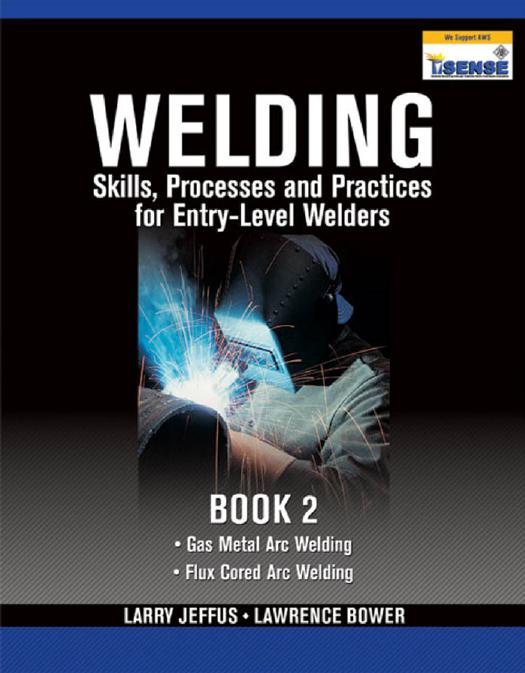Welding Skills Processes-02 by Welding

Author:Welding
Language: eng
Format: epub, pdf
8
+ 1" –
1"
1"
4
16
4
106
CHAPTER 2
Figure 2.50 GMAW (spray transfer) workmanship qualification test
Source: Courtesy of the American Welding Society
Gas Metal Arc Welding
107
Preparation of Base Metal:
The bevels are to be flame cut on the edges of the plate before the parts are assembled. The beveled surface must be smooth and free of notches.
Any roughness or notches deeper than 1/64 in. (0.4 mm) must be ground smooth.
All hydrocarbons and other contaminations, such as cutting fluids, grease, oil, and primers, must be cleaned off all parts and filler metals before welding. This cleaning can be done with any suitable solvents or detergents. The groove face and inside and outside plate surface within 1
in. (25 mm) of the joint must be mechanically cleaned of slag, rust, and mill scale. Cleaning must be done with a wire brush or grinder down to bright metal.
Electrical Characteristics:
The current shall be direct-current electrode positive (DCEP). The base metal shall be on the negative side of the line.
Electrode
Welding Power
Shielding Gas
Base Metal
Type
Size
Amps
Wire-feed Speed
Volts
Type
Flow
Type
Thickness
ipm (cm/min)
E70S-X
0.035 in.
180 to 230
400 to 550
25 to 28
Ar plus 2% O2 or
30 to 50
Low-
1/4 in. to 1/2 in.
(0.9 mm)
(1016 to 1397)
90% Ar/10% CO2
carbon
(6 mm to 13 mm)
steel
E70S-X
0.045 in.
260 to 340
300 to 500
25 to 30
Ar plus 2 O2 or
30 to 50
Low-
1/4 in. to 1/2 in.
(1.2 mm)
(762 to 1270)
90% Ar/10% CO2
carbon
(6 mm to 13 mm)
steel
Preheat:
The parts must be heated to a temperature higher than 50°F (10°C)
before any welding is started.
Backing Gas:
N/A
Safety:
Proper protective clothing and equipment must be used. The area must be free of all hazards that may affect the welder or others in the area. The welding machine, welding leads, work clamp, electrode holder, and other equipment must be in safe working order.
Welding Technique:
Using a 3/4-in. (19-mm) or larger gas nozzle for all welding, first tack weld the plates and backing strip together according to the drawing below. There should be about a 1/4-in. (1.6-mm) root gap between the plates with V-grooved or beveled edges. Use the E70S-X arc welding electrodes to make a root pass to fuse the plates together. Clean any silicon slag from the root pass, being sure to remove any trapped silicon slag along the sides of the weld.
Using the E70S-X arc welding electrodes, make a series of stringer filler welds, no thicker than 1/4 in. (6.4 mm), in the groove until the joint is filled.
Interpass Temperature:
The plate should not be heated to a temperature higher than 350°F (175°C) during the welding process. After each weld pass is completed, allow it to
108
CHAPTER 2
cool but never to a temperature below 50°F (10°C). The weldment must not be quenched in water.
Cleaning:
Any slag must be cleaned off between passes. The weld beads may be cleaned by a hand wire brush, a hand chipping, a punch and hammer, or a needle-scaler. All weld cleaning must be performed with the test plate in the welding position.
Visual Inspection:*
Visually inspect the weld for uniformity and discontinuities.
1. There shall be no cracks, no incomplete fusion.
2. There shall be no incomplete joint penetration in groove welds
except as permitted for partial joint penetration welds.
3. The Test
Download
This site does not store any files on its server. We only index and link to content provided by other sites. Please contact the content providers to delete copyright contents if any and email us, we'll remove relevant links or contents immediately.
| Drafting & Mechanical Drawing | Fluid Dynamics |
| Fracture Mechanics | Hydraulics |
| Machinery | Robotics & Automation |
| Tribology | Welding |
Whiskies Galore by Ian Buxton(40329)
Introduction to Aircraft Design (Cambridge Aerospace Series) by John P. Fielding(32338)
Small Unmanned Fixed-wing Aircraft Design by Andrew J. Keane Andras Sobester James P. Scanlan & András Sóbester & James P. Scanlan(32141)
Craft Beer for the Homebrewer by Michael Agnew(17445)
Turbulence by E. J. Noyes(7037)
The Complete Stick Figure Physics Tutorials by Allen Sarah(6638)
Kaplan MCAT General Chemistry Review by Kaplan(6053)
The Thirst by Nesbo Jo(5785)
Bad Blood by John Carreyrou(5768)
Learning SQL by Alan Beaulieu(5410)
Weapons of Math Destruction by Cathy O'Neil(5036)
Man-made Catastrophes and Risk Information Concealment by Dmitry Chernov & Didier Sornette(4735)
iGen by Jean M. Twenge(4702)
Digital Minimalism by Cal Newport;(4540)
Life 3.0: Being Human in the Age of Artificial Intelligence by Tegmark Max(4507)
Audition by Ryu Murakami(4098)
1,001 ASVAB Practice Questions For Dummies by Powers Rod(4038)
Electronic Devices & Circuits by Jacob Millman & Christos C. Halkias(4027)
Pale Blue Dot by Carl Sagan(4001)
